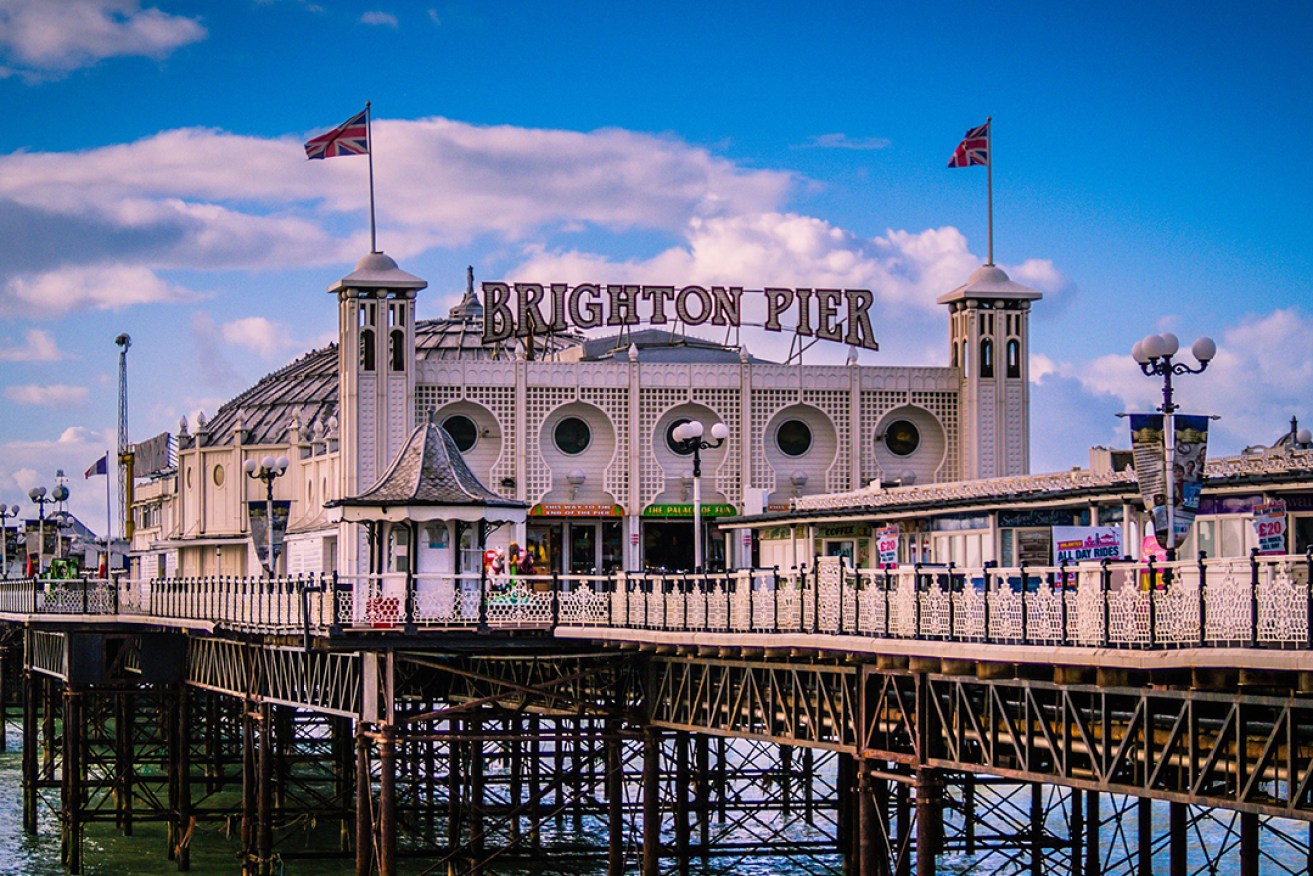Why the Brits do like to be beside the seaside
You won’t visit for an amazing beach experience but there’s plenty to recommend those quintessential coastal towns that provided the backdrop to many British dramas we’ve watched over the years.

Brighton Pier. (Photo: WellTravelled.Media)
In the age of low cost, fast, efficient mass transport, the traditional “trip to the seaside” for English holidaymakers has largely been replaced by more exotic continental sojourns.
Don’t be mistaken though that these once-thriving short break destinations are little more than nostalgia trips these days – most are still buzzing and the charm is still very much there.
Here are our top five must-see seaside towns that offer more than just the glimpse of a bygone era.
BRIGHTON – East Sussex
Brighton first established itself as a seaside resort in the mid-18th century due to the emerging “trend” in sea-bathing and it cemented its reputation as a getaway destination when the hedonistic Prince of Wales (the future George IV) began visiting the town in the 1780s with his mistresses.
In recent years, the place that evokes images of car rallies from London, beach raves, Mods and Rockers and a lively gay scene has undergone a transformation – out are the dingy B&Bs and the tatty seafront and in their place, groovy bars, classy restaurants, slick hotels and a cool Bohemian vibe.
Today the seafront is abuzz with joggers, dog walkers, Tai Chi classes and loads of cafes serving gourmet breakfasts and popular mochas. Further along the seafront towards the famous pier, seafood vendors offer mussels, shrimps and jellied eels from their kiosks and beach attendants rent deckchairs and umbrellas.
The Brighton Pier is still the place to go for some classic seaside fun with its amusement halls and iconic fairground rides like the ghost train, helter-skelter and golden carousel.
Just back from the beach are more essential experiences – get lost in the atmospheric maze of streets that make up the Lanes, once a fishing village and now a cornucopia of designer boutiques, restaurants and antique shops. Close by is the Royal Pavilion, former home of King George IV, and probably the most exotic, extravagant royal palace in Europe.
BLACKPOOL – Lancashire
Blackpool is England’s archetypal fun-by-the-sea resort. Love it, loathe it or both, the “Las Vegas of the Lancashire Coast” may be tacky and cheesy but it continues to attract crowds year-after-year. When the rail line opened in 1846, Blackpool became one of the country’s first seaside resorts for the working classes.
From the mid-19 century, whole Lancashire mill towns would descend on Blackpool for the “Wakes Weeks” annual holiday, spending their hard-earned cash living the good life for a few days, strolling its three piers and watching the likes of Frank Sinatra, Judy Garland and Bob Hope perform at the Grand Theatre.
Perhaps Blackpool’s best-known attraction and the reason for its continued popularity is the Pleasure Beach which evolved from a gypsy encampment in the early years of the 20th century. Today, this wonderful theme park houses a marvellous collection of old-style wooden roller coasters such as the world’s first Big Dipper (1923) along with modern high-tech ones like the Pepsi Max Big One.
If the pier is Brighton’s trademark, then Blackpool’s is its 157m-tall tower modelled on the Eiffel Tower and erected in 1894. In addition to offering tower top views, inside is the Tower Circus and the magnificent Tower Ballroom.
After the summer months when other English seaside resorts begin to wind down, Blackpool extends its holiday season with another star attraction. Five miles of the Promenade are illuminated with 500,000 coloured light bulbs – the world-famous Blackpool Illuminations.
IVES – Cornwall
The spectacular crescent-shaped Porthmeor Beach is the focal point for all visitors to St Ives from families with their buckets-and-spades, to couples and surfers. You only have to stroll along its rippled sands on a sunny day, with the ever-changing light bouncing off the Atlantic surf, to realise why this once busy pilchard-fishing village has become the hub of the county’s art scene.
The jewel of the art crown is the Tate St Ives that stands proudly on the hillside behind the beach. Peruse the works of celebrated local artists like Barbara Hepworth and Patrick Heron before enjoying an alfresco lunch on the stylish rooftop terrace with picture-postcard views. More of Barbara Hepworth’s sculptures can be seen dotted around town and her larger works are on display at the Barbara Hepworth Museum and Sculpture Garden on Barnoon Hill.
In the heart of town, a network of cobbled lanes is crammed with art studios, surf shops, brasseries and several bakeries selling those famous hearty Cornish pasties. This fusion of traditional seaside elements and boutique chic makes for an interesting mix and although it can get busy in peak season, St Ives remains an essential Cornish tour stop.
If the summer crowds become too much, then walk a small section of the 1000-kilometre South West Coast Path for a taste of Cornwall’s stunning coastal scenery. The 10-kilometre stretch from St Ives to Zennor features a series of plunging descents into rocky coves and steep ascents to headlands offering panoramic views of the turquoise waters below.
WHITBY – North Yorkshire
Much of Whitby’s wide-ranging appeal stems not only from its rich seafaring history and moody setting but from the two sides of its character – one as a working fishing port and the other as a traditional seaside resort.
The imposing ruins of the 13th-century abbey dominate the skyline where narrow stone lanes and red-bricked houses spill down the slopes of the headland to a natural harbour below.
Along the waterfront, amusement arcades shriek their chaotic sound while the sea air is tinged with the sweet aroma of candy floss and toffee apples. Brightly painted fishing boats line the quayside where salty characters unload their quarry destined for the town’s fish market and numerous fish and chip shops.
Whitby has managed to retain much of its 18th-century character. The fact Captain James Cook – the town’s most famous (adopted) son – completed his apprenticeship here as a seaman (between 1747 and 1755) and sailed from this tiny harbour is a strong drawcard.
Visit the house in Grape Lane where Cook studied, which today is a museum in his honour, then take the pilgrimage stroll to the West Cliff where the bronze statue of the great navigator stands for panoramic views over the town and the Esk River.
On the opposite headland, the famous 199 steps hug the hillside and lead to the ruins of the abbey and its sombre graveyard of ancient tombstones. This haunting setting was the inspiration for Dracula by Victorian novelist Bram Stoker who wrote the classic in a B&B in the old part of town in 1897. Fans wanting more can visit the walk-through Dracula Experience on Marine Parade and the tourist office sells an excellent Dracula Trail leaflet to visit some of the featured sites.
MARGATE – Kent
The fortunes of this popular English seaside holiday town have ebbed and flowed since JMW Turner produced seascapes here in the 19th century. Tourism numbers dwindled in the second half of last century but recently Margate has stepped firmly back on the tourist map thanks largely to a programme of major cultural regeneration projects, including the Turner Contemporary gallery which highlights the town’s links with the famous artist and the reopening of the iconic Dreamland amusement park in 2013.
The long stretches of clean, sandy beaches and the 40km Viking Coastal Trail are still the main attractions and the old town and Harbour Arm have a distinctive arty feel, with quirky shops, galleries and great places to eat. Open-air live music, art exhibitions and festivals all bring Margate to life throughout the summer months.
Other activities providing year-round entertainment include amusement arcades, the Hornby Visitor Centre (featuring model railways and cars) and the mysterious Shell Grotto.
Discovered in 1835, this subterranean world is a collection of winding passages leading to a rectangular chamber, its walls decorated with strange symbols and mosaics. Situated about 2km along the seafront heading east is the Tom Thumb Theatre, believed to be the world’s smallest working theatre.
Eating by the seaside
Fish & chips
Battered cod or haddock and thick-cut potato chips – both deep-fried, salted and sprinkled with vinegar, is an iconic English dish dating back to the 1860s – and there’s still a special magic about eating them by the sea. The Magpie Cafe overlooking the harbour in the old whaling port of Whitby is a top choice to enjoy some of the best along England’s east coast.
Cornish pasties
During the 17th and 18th centuries, the Cornish pasty was adopted by local farmers and tin miners as a tasty, portable and sustaining meal. The family-run Chough Bakery by the quayside in Padstow near St Ives produces traditional and award-winning pasties filled with locally-sourced beef, potato, onion and swede plus an extra dollop of ‘Cornishness’ in the form of some clotted cream.
Cockles and mussels
A typical feature of many English seaside towns is the seafood stall. Manning’s Seafood Stall in Margate takes this good old seafood snacking tradition to new heights – and along with coastal mainstays such as whelks, cockles, prawns and mussels, Manning’s also serves plump oysters with lemon and tabasco served with cold glasses of Prosecco.
– WellTravelled.Network












